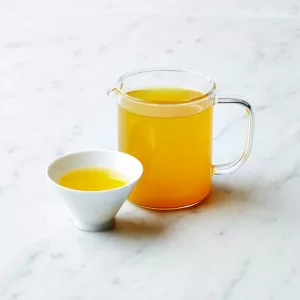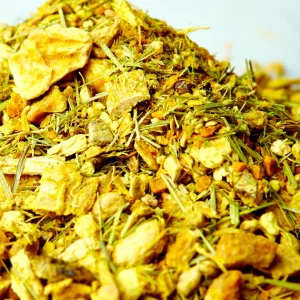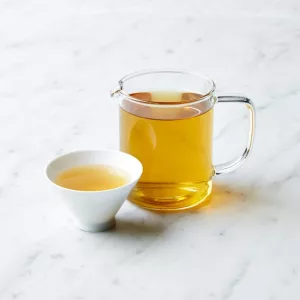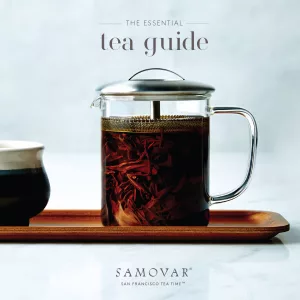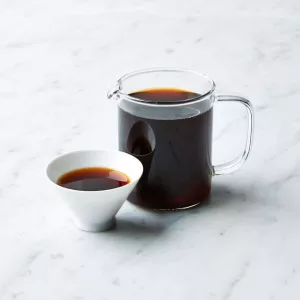
With all the New Year’s celebrations of the last couple months, I thought I’d write about a more obscure and subdued New Year’s celebration that I attended: Robiraki. You may never have heard of Robiraki because it usually takes place in November. November, in the world of Chado, the Japanese tradition of tea preparation, is the month of the first tea of the winter season.
Robiraki is very much the Tea New Year for practitioners of Japanese tea. Two exciting things happen in November:
1) The tea that was picked, processed, and put into storage to settle in the Spring is unveiled and turned into Matcha (powdered green tea). And…
2) The hearth upon which the water is boiled for making tea in the Japanese tearoom goes from resting above ground for the warmer months, to being in the ground for the winter. So, the furo (literally “wind hearth,” or brazier) season changes to the ro (sunken hearth) season.
Robiraki is simply an excellent opportunity to gather friends together to celebrate the changing of the season and to finally sample the year’s Matcha harvest.
Where I live, in San Francisco, we don’t have the blessing of obvious season change. No crimson and golden fall leaves, no white (or yellow) snow, our summer days come in patches throughout the year… so its really nice to have an event like this to mark the passage of time.
This past November, the San Francisco chado students celebrated Robiraki at the Urasenke Foundation school of chanoyu. It was a blustery, rainy day, the kind where rain is coming at you from all directions. Arriving at the school with umbrella and ankle-length raincoat, I was transported into another, much dryer world.
The space had been prepared so beautifully. On display, in a hollowed out gourd, were all the instruments used to build the fire: a beautiful brown and gray feather from a female peacock, large cylinders of charcoal, small sticks covered with some white substance for kindling, the iron rings for carrying the kama (caste iron cauldron), and a wild boar-shaped incense container.
Guests came from all over the Bay area, including the Urasenke teacher at Green Gulch Farm Zen Center in Muir Beach and two of her students. After settling into the quiet and dry dream world of the tearoom, we were served the zenzai, which was unlike anything I have ever had before: it was like a sweet red bean soup with whole red beans and the most delicious toasted mochi floating in it. It was such a treat!
In the tea room, the tokonoma (art alcove) had a gorgeous flower placement with a branch of orange and red leaves that looked like maple (but weren’t) and a very unusual pink Camellia that Christy Sensei searched far and wide for and finally found in a secret garden in Berkeley.Once the ro season has begun, we no longer see the wild flowers of spring and summer in the tearoom (even though we still find them in SF), now the only flowers are of the evergreen Camellia.
The scroll that hung in the tokonoma had bold characters that said MU JIN ZO, which means the Inexhaustible Treasure House– a sentiment that moved us to reflect on the inexhaustible treasure house of our lives.
For Robiraki thick tea (koicha) is served. This was only my second time drinking koicha and I have to say that it is definitely an acquired taste. To prepare it, it looked like the host poured in a whole 20 gram natsume (tea caddy) into the tea bowl (cha wan). Then she gracefully mixed the powder with boiling water using a bamboo whisk (chasen).
A higher grade, sweeter leaf tea is used for koicha than for the thin, frothy tea (usucha) that we serve at Samovar and learn to make as chado beginners. I was thankful for this sweeter Matcha because the koicha was potent enough without having too much bitterness to it. It was really something else: the consistency reminded me of hot fudge, and coated my mouth like smooth, thick, Matcha syrup.
Within moments my body felt the effects of such a concentrated dose of caffeine, catechins, vitamins, and anti-oxidants. Needless to say I was kookoo that evening… very, very jacked up.
Once everyone had had their share, we finished the Robiraki by admiring the utensils used to prepare the tea and the bowls used to serve it. That is one of my favorite parts of tea “ceremony;” the appreciation of all the attention to detail and careful selection of items by the host and recognition of the craftspeople who made the beautiful things that have been shared.
When I left the tea room, night had fallen and the rain had let up a bit. The first tea of the winter season coincided with the first rain. Things are in sync in the world of tea.
-Christine

